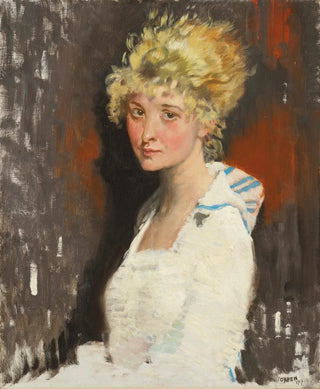Art print | The model of the artists Yvonne - William Orpen


View from behind

Frame (optional)
In the vast panorama of art history, some works manage to capture the very essence of their era while transcending time. "The Artist's Model Yvonne" by William Orpen is undoubtedly one of these iconic creations. Created in the early 20th century, this canvas evokes an atmosphere of sophistication and sensuality, while revealing the subtleties of relationships between artists and muses. The piece, both intimate and universal, invites the viewer to enter a world where beauty and creativity intertwine inextricably. It does not merely depict a model; it embodies a reflection on the artistic process itself, on inspiration and the impact a muse can have on a painter's work.
Style and uniqueness of the work
Orpen's style, characterized by striking realism and meticulous attention to detail, is fully expressed in this piece. The choice of colors, textures, and play of light creates a palpable, almost tangible atmosphere. The figure of Yvonne, both delicate and assertive, is highlighted by a subtly blurred background that emphasizes her importance in the composition. Orpen succeeds in capturing not only the physical beauty of his model but also an emotional depth that resonates with anyone who gazes upon this canvas. The nuances of flesh, drapery, and shadows are rendered with such virtuosity that they seem to almost vibrate under the viewer's gaze. This blend of realism and lyricism gives the work a nearly poetic dimension, inviting each viewer to an introspective contemplation.
The artist and his influence
William Orpen, a major figure of the British artistic movement, knew how to, through his talent, mark his era. Raised in a context where art was undergoing rapid change, he navigated between tradition and modernity, incorporating diverse influences while developing a personal style. Orpen is not content to be merely a portraitist; he is a chronicler of his time, capturing the nuances of society and human emotions with rare finesse. His approach to painting, marked by a deep empathy for his subjects, allowed him

Matte finish

View from behind

Frame (optional)
In the vast panorama of art history, some works manage to capture the very essence of their era while transcending time. "The Artist's Model Yvonne" by William Orpen is undoubtedly one of these iconic creations. Created in the early 20th century, this canvas evokes an atmosphere of sophistication and sensuality, while revealing the subtleties of relationships between artists and muses. The piece, both intimate and universal, invites the viewer to enter a world where beauty and creativity intertwine inextricably. It does not merely depict a model; it embodies a reflection on the artistic process itself, on inspiration and the impact a muse can have on a painter's work.
Style and uniqueness of the work
Orpen's style, characterized by striking realism and meticulous attention to detail, is fully expressed in this piece. The choice of colors, textures, and play of light creates a palpable, almost tangible atmosphere. The figure of Yvonne, both delicate and assertive, is highlighted by a subtly blurred background that emphasizes her importance in the composition. Orpen succeeds in capturing not only the physical beauty of his model but also an emotional depth that resonates with anyone who gazes upon this canvas. The nuances of flesh, drapery, and shadows are rendered with such virtuosity that they seem to almost vibrate under the viewer's gaze. This blend of realism and lyricism gives the work a nearly poetic dimension, inviting each viewer to an introspective contemplation.
The artist and his influence
William Orpen, a major figure of the British artistic movement, knew how to, through his talent, mark his era. Raised in a context where art was undergoing rapid change, he navigated between tradition and modernity, incorporating diverse influences while developing a personal style. Orpen is not content to be merely a portraitist; he is a chronicler of his time, capturing the nuances of society and human emotions with rare finesse. His approach to painting, marked by a deep empathy for his subjects, allowed him






